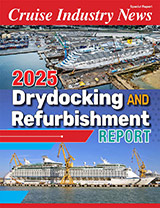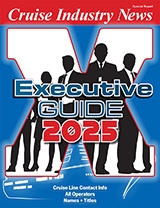The Caribbean and the Bahamas will command approximately 50 percent of the worldwide cruise capacity in 2004, with 6.4 million passengers, up five percent from 2003, according to estimates by Cruise Industry News.
This compares to an 11 percent increase in capacity in 2003 over 2002.
More than 85 percent of the passengers sailing in the Caribbean will be carried by the seven largest brands – approximately 36 percent by Carnival Cruise Lines, 26 percent by Royal Caribbean International, 7.5 percent by Princess Cruises, 5.5 percent by Norwegian Cruise Line, 4.5 percent by Holland America Line (HAL) and by Celebrity Cruises, and two percent by Costa Cruise Line.
Caribbean Developments
With more ships moving in, ports and destinations are working to keep up with the growth and so are the cruise lines. Carnival Corporation announced recently that it is building is own port facility in Grand Turk on the Turks and Caicos islands. In addition, Carnival is also pushing its project in Cancun which is mired in local political issues.
Moreover, HAL has project underway in Tortola which the company said “it is not ready to talk about.”
Both Carnival and Royal Caribbean Cruises (RCC) have also submitted proposals to Belize to build their own docks there, according to sources in Belize.
RCC is already involved as part owner of the company that owns the so-called Tourism Village, which is the entry-point for all the passengers arriving in Belize. RCC’s partner is Diamond’s International.
Belize reported 575,196 passengers in 2003, up 80 percent over 2002, and is projecting another increase of 36 percent for 2004.
While Belize is happy with the cruise traffic, government officials said they hoped the cruise lines would source more of their provisions in Belize and contribute to infrastructure development.
Jamaica is also looking for more interaction between cruise lines and islands.
“The cruise lines (should just) get more involved in the Caribbean as a whole,” explained William Tatham, vice president of cruise shipping and marina operations for the Port Authority of Jamaica. “Significant contributions can be made in the areas of employment, purchasing and investment. I feel that this is not fully recognized by the cruise lines, as well as the governments and hoteliers of the regions,” he added.
At the St. Maarten Port Authority, Managing Director Rommel Charles, echoed many destinations when he said he would like to see a more even flow of visiting cruise vessels.
“At present, there is a tendency for very high activity on two or three days, and significantly less activity on the other days of the week,” Charles said.
In Antigua, Cameron Fraser, managing director of Antigua Pier Managment, said his current project is to convince the cruise lines that Antigua can be included in a seven-day itinerary from Florida.
Fraser said he was trying to attract Disney Cruise Line, which has made a number of trail calls in Antigua, and he is also working to encourage Holland America Line to call there.
“Traditionally it was assumed that St. Maarten was the furthest that a seven-day Eastern Caribbean deployment could reach,” he noted. “We are starting to see results with trial calls on these deployments from Disney, Princess and Royal Caribbean being undertaken this year.”
Meanwhile, in Curacao, Dino Daal, product development manager at the Curacao Tourist Board, expressed concern that with the shift in cruise traffic toward the Wes tern Caribbean, the Southern Caribbeanan is suffering. The region continues to be dependent on San Juan for seven-day cruises. This year, 80 percent of Curacao’s cruise traffic will come in the November through April period.
Priorities
Near-term pnontles include security concerns. Tatham said the Jamaican Port Authority is working to put all the new security measures in place in an orderly and timely fashion. Part of the work will be to inform all the users – taxis, tour operators, etc. – how the new measures will impact their operations.
Since Jamaica is also a homeport, other security systems include X-ray machines, underwater cameras for hull and berth inspections, closed circuit television, security zones, floating barriers and patrol boats.
In ST. KITTS, General Manager David Cable, said that the port authority was working to implement the ISPS code my mid-2004 as required.
St. Maarten is also in the process of implementing the ISPS code, according to Charles.
Work will also soon begin in Montego Bay, enabling that facility to handle even larger vessels.
New Developments
A new cruise facility is near completion in Grenada and will be able to accommodate two mega ships, according to Nikoyan Roberts, senior product development manager for the Grenada Tourist Board.
Plans also call for Grenada to develop 10 new tour and shopping products for cruise passengers by the end of 2004.
In St. Thomas, the Crown Bay dock is expected to be completed by July 2004. Said Darlan Brin, executive director of the Virgin Islands Port Authority (VIPA), “The dock is being expanded up to 1,000 feet on the north and south sides and will be able to handle some of the biggest ships when completed.
Also in St. Thomas, the West Indian Company (WICO) is preparing for the Ultra Voyager, according to Alfred Lloyd, director of dock operations. WICO has submitted plans to the Army Corps of Engineer for a 100-foot extension of its docks.
WICO has also rebuilt the bulkheads of the docks – right down to the bedrock, according to Lloyd, so they can withstand the concentrated power of three mega-ships with podded propulsion.
Antigua is gearing up to start more homeporting services. Work includes better facilities for dispatching tours. Extensive work is also being done at the airport to prepare for the anticipated increase in arrivals.
Next year, Fred. Olsen Cruises will offer its winter Caribbean program from Antigua.
In Martinique, Jacques Baj al, director of the cruise department of the Martinique Tourist Board, said that a call by the Queen Mary 2 had helped boost interest in cruising among the local press, policy-makers and the public.
In nearby St. Barts, Jerome Montoya, operations manager for S.M. T .A., said that Gusta via’ s tender pier has been completely renovated for the 2003-2004 season and there is now more room for easier operations.
Also to come is a new high-speed ferry from St.Maarten, traveling up to four or five times a day between the islands in just half an hour. Passengers on bigger ships calling in St. Maarten will be able to come and visit St. Barts, he said.
Montoya believes that the summer could be a great opportunity for bigger ships to call in St. Barts.
In St. Maarten, work is underway to berth four mega-ships at the same time – including increased bollard capacity on the pier, construction of additional bollards off the pier and increasing the length of the pier via additional dolphin clusters, according to Charles.
Traffic is Mostly Up
While Caribbean cruise traffic is up overall, it is not up for everybody.
Traffic to the Wes tern Caribbean and Mexico is up. Jamaica reported more than one million cruise passengers last year – a new record for the island.
In St. Thomas, WICO forecast 153 more calls in 2004 over 2003 which had 855 calls.
Antigua reported 355,000 for its fiscal year, ended Oct. 31, 2003, up slightly from 330,000 in 2002, but expects a dramatic increase up to 621,000 this year.
Curacao saw a drop in 2003 to about 300,000 from 278,000 in 2002 and expects the traffic to stay flat in 2004.
Dominica said the outlook for 2004 was very positive, but did not provide any numbers. The reason for its optimism is partially the Carnival Destiny, which is dropping Martinique in favor of Dominica.
Martinique reported 280,800 cruise passengers in 2003, which Baja! said was a 35 percent increase over 2002. The problem is that the Carnival Destiny, which has left, represented 57 percent of the cruise traffic.
Grenada reported nearly 147,000 passengers in 2003 and, with its new facility, expects that to grow to nearly 260,000 in 2004.
Upscale St. Barts, which caters mostly to smaller ships, had about 35,000 passengers in 2003 and predicted 50,000 this year.
St. Kitts reported 161,000 passengers in 2003, what it called a moderate increase over 2002, and expects nearly 260,000 in 2004, including calls by two new ships, the Golden Princess and the Regal Princess.
In St. Maarten, Charles said the passenger throughput for 2003 was 1.2 million, and that he expects a 10 percent increase in 2004.
Last year’s traffic would been higher had it not been for the withdrawal of the Norway.
While St. Thomas had a busy year as usual, VIPA said that with the pull-out of cruise ships from St.Croix, its passenger volume was down in 2003.
Sales Pitch
In Curacao, Daal said that a recent study showed that the island rated at least a seven on a 10-point scale on the 19 out of 30 items deemed important to cruise lines’ port selection. Curacao’s highest mean scores were for political stability (8.5) and passenger safety (7.9).
Daal also said that Curacao has developed several new adventure-types of tours, including kayaking, canoe safaris and horseback riding.
The island is also working to strengthen its cruise conversion program ( converting passengers to return as hotel or resort guests). Meanwhile, the over-riding objective for cruise tourism is to maximize the net economic benefit to the island.
Objectives
Said Jamaica’s Tatham: “We anticipate significant growth in the coming years, and as such we are looking to expand the ports of Montego Bay and Ocho Rios. We are also looking to develop the Port of Lucea as a possible new port of call in the next few years.
“We see ourselves as a potentially strong homeport, as we have the potential to open Central and South American itineraries. Having successfully homeported Seetours and Sun Cruises over the last few years, we feel we have gained the experience to take this to the next level and provide better and more efficient services.
In St. Maarten, Charles also sees potential for growth: “We see the further business growth as a destination on cruise itineraries in the short term. We also see possibilities for homeporting growth in the long term. Careful study and planning is necessary, however, and we are proceeding accordingly.”
In Grenada, Roberts said the focus was on completion of the new facility and the island’s ability to accommodate two to three mega-ships.
Problems are also being tackled. Sidewalk vendors in St. John’s (Antigua) now have a new mall instead, located between the two shopping areas at the base of the cruise ship piers, according to Fraser, who added that plans were also underway to improve the taxi dispatching.
In Martinique, where taxis have always been an issue, drivers must now show identification that authorizes them to work in the cruise terminal area.
What Baja! called “civilian officers” have also been walking and riding on bicycles throughout Martinique on weekdays, their role being prevention, mediation, and information for the police and the visitors as well as the local population.
A new terminal project is set to start in Fort de France in late 2004, creating a “cruise village.”
In Grenada, Roberts also expressed the wish that the cruise lines would assist the island in providing training opportunities for both front line service providers and internships for supervisory level personnel.
Such involvement are areas that cruise lines should look at, according to Tatham, who said they could be substitutes to taxes.



